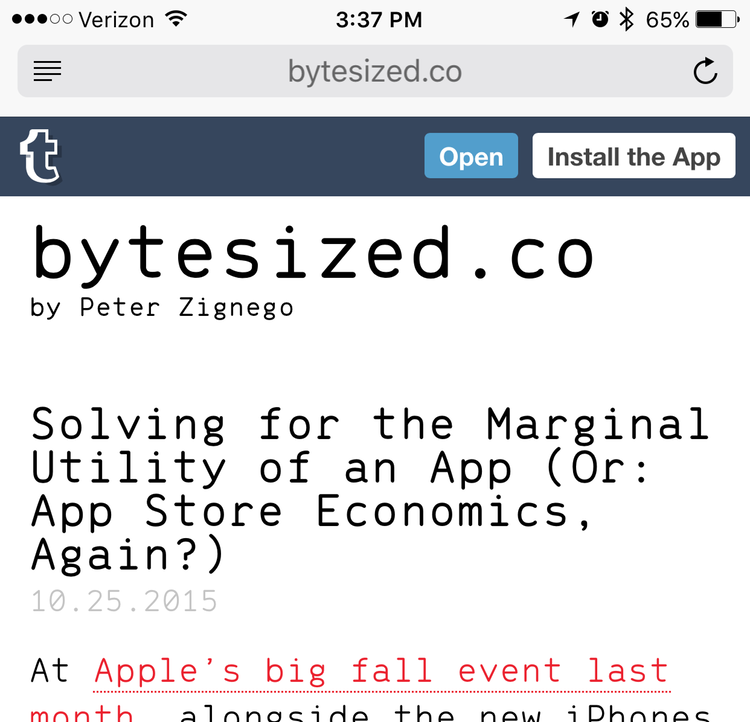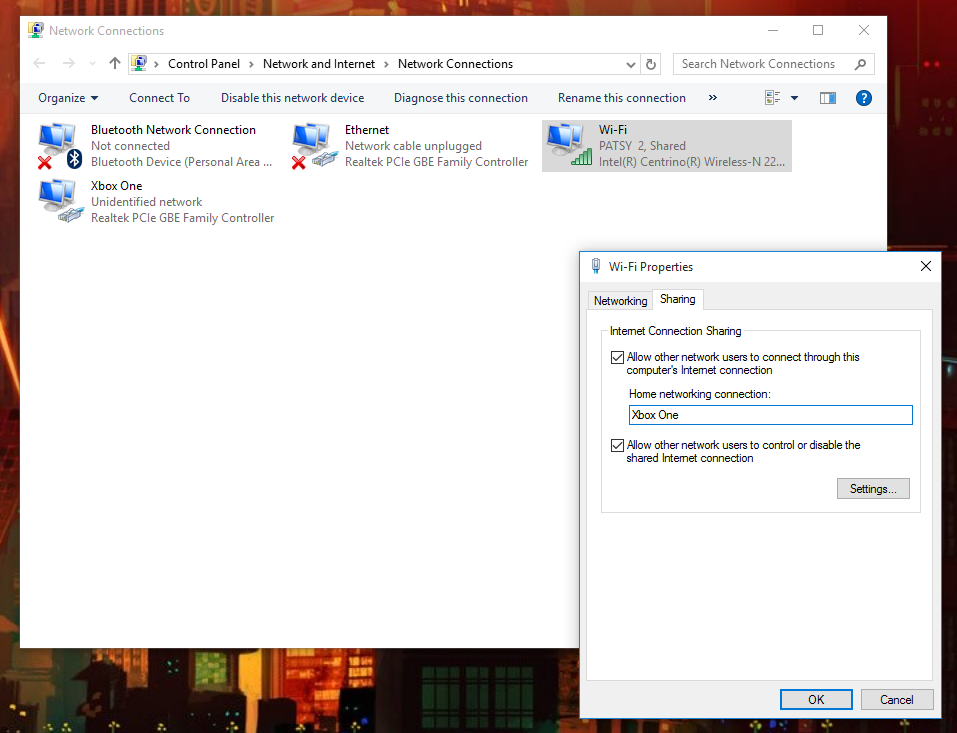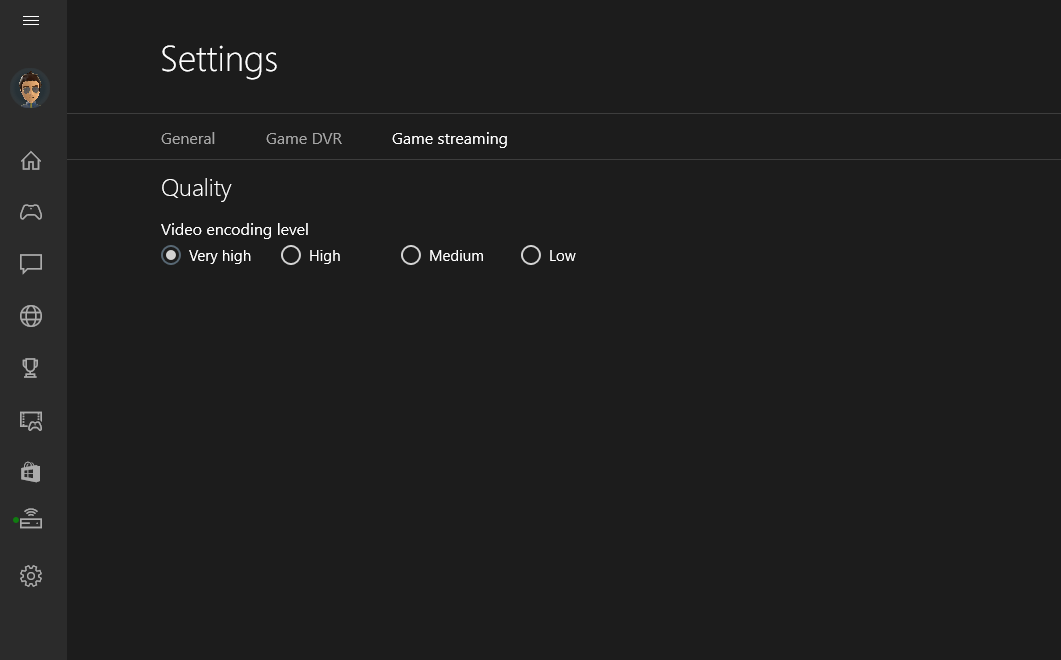I love year end lists - for the list reader they’re an excellent way to take in annualized curation (the internet is a big place and it’s easy to miss great stuff!). For the list maker they’re a great way to look back on the year that was and take stock of it. Here are my year end lists for 20151.
Music
Apps (iOS)
Apps (Mac)
Games
Earlier this year, I took a look at the options for hosting a blog in 2015. I ended up settling on Tumblr, tweeting:
Tumblr was always a weird place to host a blog in the traditional sense of the word. I had settled on it because I found their custom theme implementation far simpler than anything else out there. And it’s hard to beat free! But Tumblr is more a social network than a blogging platform - they introduced messaging in November. It began to feel like I was having to fight harder and harder against the interface - avoiding reblogs, likes, usernames. So when I visited my site on my iPhone a few days ago and was greeted with a floating banner promoting the tumblr app, I knew it was time for a change.

I had been tangentially aware of Realmac Software’s new crowd-funded blogging platform, Typed.com. So when Dan Counsell tweeted about rolling out beta access to theme support, I took the plunge.
A few hours later, I had my transferred my layout, added my old posts, and switched over my domain.
Things I Liked:
- Full customization - there’s no required boilerplate.
- The sample theme provides a good jumping off point.
- Simplicity. If you know basic CSS and HTML, you should have no problem customizing your blog to your liking with the help of the documentation.
- The Theme Preview.app makes it easy to perfect your theme locally.
- Markdown and raw HTML support.
- The ability to backdate posts. This allowed me to bring over my existing posts with their existing post dates.
- Post tagging support.
Things I Disliked:
- No ability to preview a post before publishing it.
- No post import. You have to bring your posts over one by one using the editor.
- You have to enter a credit card number to sign up for the 'free trial'. On the Typed.com home page, they explain it like this:
To ensure your Typed website remains accessible to readers at the end of your trial, we require a credit card to start one.
This is cheesy explanation for what is a customer hostile business decision, plain and simple. When you require a credit card to sign up for your free trial, you’ve already got me questioning your intentions - don’t exacerbate it by trying to bullshit me on why.
Would I recommend Typed? That’s a hard question to answer. A recurring subscription is a hard sell for something with a lot of free alternatives out there. If you’re willing to deal with a few annoyances, you could use Tumblr for free like I was. If you don't need or want to control the design of your blog, you'd be hard pressed to do better than Medium - I’ve been cross posting my blog posts there and find the experience to be excellent. But if you're serious about having a good old-fashioned blog, Typed provides a great experience for a reasonable price.
At Apple’s big fall event last month, alongside the new iPhones and a larger iPad, they unveiled an entirely new platform - tvOS. The announcement has stirred up fresh discussions of an evergreen topic for Apple’s third-party developers - the sustainability of building software for Apple’s platforms. I’ll be focusing on the ‘what’ and the ‘how’ here - the ‘why’ has been covered extensively.
Apple’s user base has grown so large, and both the company and it’s products have so much momentum, that it seems unwise to bet against their success. As with the Apple Watch, there will be thousands of applications available on launch day for tvOS regardless of how many words are spilled over App Store sustainability. But will Apple’s new platform for the living room support a strong independent software market like the one that has sprung up around the Mac, or will it more closely resemble the race-to-the-bottom freemium graveyard that is the iOS App Store?
Brent Simmons summarizes one position nicely: could it be simple ‘bigger is better’ psychology at work - that the bigger the screen, the more money you can charge? No - software’s value has never and will never be determined by it’s 'physical' size. Software’s value comes from the marginal utility that people get from it.
Using this framing, it’s clear that the market for tvOS apps will closely mirror what we see dominate the iOS app store - free applications with in-app purchases. The vast majority of the applications we use on our phones are for entertainment, not productivity.1 As Ben Thompson eloquently put it in a recent article about Facebook:
It is only when we’re doing something specific that we aren’t using our phones, and the empty spaces of our lives are far greater than anyone imagined.
Most apps are simply entertainment,2 filling in those empty spaces in our lives. And while people enjoy being entertained, the marginal utility of being entertained by one app instead of another, or by something else entirely, is minuscule. This devaluing of entertainment happens everywhere, even though it’s easiest to recognize when the hornet’s nest that is the internet gets stirred up. It’s a time honored tradition to complain about how much movie ticket prices have gone up while you’re waiting in line to see a movie. The amount of time it takes to complete a video game has become a major component of modern game reviews because people care so deeply about that dollars per hour calculation. All these things are manifestations of the strange mental calculus we perform that informs what intangible entertainment "experiences" are worth.
When your product is entertainment, you’re competing for attention - and everything is competition. Even highly differentiated experiences don't produce an overwhelming increase in marginal utility for most people. I believe 99% of tvOS applications will fit the mold of apps as entertainment, and that the overall market for apps on the TV will be relatively small.3 In opposition to the phone, where you can seek out and discover new apps in those empty spaces, sitting down and turning on your TV set and Apple TV requires intent, a far greater hurdle. This is in direct conflict with how most people consume TV today - it is the ultimate passive consumption medium.
The top applications will be well known content destinations - the traditional networks (ABC, CBS, NBC, etc.), along with Netflix, Hulu, and their ilk. The biggest potential winners on the platform will be the Youtubes and Twitches of the world - the new media companies that will be able to create new, dynamic consumption experiences that leverage the large screen and unique potential for having paired iOS devices as a second screen - the most advanced remote control in the world.
All this isn’t to say I think that the Apple TV will be a failure - far from it. With Apple’s momentum and the support from third-party developers,4 I think that the Apple TV will be a tremendously successful platform for consuming content. That just isn’t the basis for a sustainable software platform.
Earlier this summer, Brent Simmons wrote an article about the current state of iOS software development:
The platform is awesome. We love writing iOS apps. It’s fun and massively rewarding in every way except monetarily. As a craft — as a budding art form, perhaps — it’s juicy.
He’s right. Even as the haze of the gold rush mentality finishes lifting, more and more people are attracted to app development — hobbyists, indies, and professionals alike. Despite the (poor) economics of the App Store, an increasing number of developers are building an increasing number of apps every day. Apple boasted over 1,500,000 apps totaling over 100 billion downloads at WWDC this year.
It’s not hard to see why. It’s a form of creative expression available to those who are more mathematically, less artistically inclined. It’s building something with your hands, seeing a form take shape you as you work — 21st century sculpting. It’s a field with expansive depth and breadth, constantly hurtling forward at incredible speed. Technically, it has never been easier to build software at any point in history than it is today. Our integrated development environment is provided free of charge. We start each application with a buffet of potential frameworks to choose from, a tremendous accumulation of prior work done by incredibly intelligent people. We barely even have to manage memory anymore. Who wouldn’t want to write software?
But Brent’s warm and fuzzy ‘do it for love’ sentiment is ruined for me by this flippant line toward the end:
What’s more likely is that you’ll find yourself working on a Mobile Experience for a Big National Brand(tm) and doing the apps you want to write in your spare time.
Don’t check your passion at the door. If you are building software, your responsibility as a developer and as a citizen of the platform is not lessened by a project that isn’t your own. Inside the indie software bubble, consulting is often considered a dirty word — an insult to the purity of focus, to building a singular product, your product. It shouldn’t be. The common thread that connects us all — the weekend code warriors, the late night tinkerers, the nine-to-fivers — is passion, the aforementioned love of building software. There is beauty of purpose in building great software, be it a beloved RSS reader or the Target app. When it’s not yours, it may not always be beautiful, and you may not always win the fights to make it the best it could be, but when it ships it will serve a purpose and make people’s lives better.
Yesterday, I spent part of my Labor Day working on a fun side project that’s unlikely to ever make significant money and loved every minute of it. Today, I went back my job as an iOS developer for a consulting company — and I loved every minute of it.
In my home office, my gaming PC and my Xbox One share a single monitor, so I was pretty excited about the Windows 10 Xbox application and the ability to stream games from a Xbox One to a PC. Unfortunately, launch day brought with it a disappointing reality - even on the highest setting, the streaming video was scaled down to 720p, which meant that my HDMI switcher was sticking around for awhile.
But today, Microsoft released an update to the Windows 10 Xbox application that unlocked a new high quality streaming option, enabling full 1080p game streaming at 60 frames per second. The visual fidelity of the game streaming was now on par with what I could get straight from the Xbox’s HDMI port - now the only issue was network bandwidth. With my router a floor below, I found that even as the only two devices on the 5GHZ band I was getting frequent stuttering as the connections between my PC and my Xbox struggled to keep up.
Fortunately, if you’re using a single monitor setup like myself, odds are good that your Xbox and PC are close enough to be wired together with an ethernet cable - but the setup isn’t exactly plug and play. Follow the steps below to share your PC’s internet connection with your Xbox One and unlock stutter-free streaming bliss.
- Connect the PC you will be using for game streaming to the internet.
- Run an ethernet cable from your Xbox One to your PC.
- Open the Network Connections control panel on your PC.
- On your connection to the internet, right click and select ‘Properties’.
- On the Sharing tab, check ‘Allow other network users to connect through this computer’s Internet connection’ and select the wired ethernet connection to your Xbox from the Home networking connection dropdown list.

- Restart your Xbox.
- Make sure you have the most up-to-date version of the Windows 10 Xbox application.
- Set your Game streaming settings to ‘Very high’.

Setup complete! Now you can connect to your Xbox One, begin streaming a game, and enjoy the speed and reliability of a wired connection.


